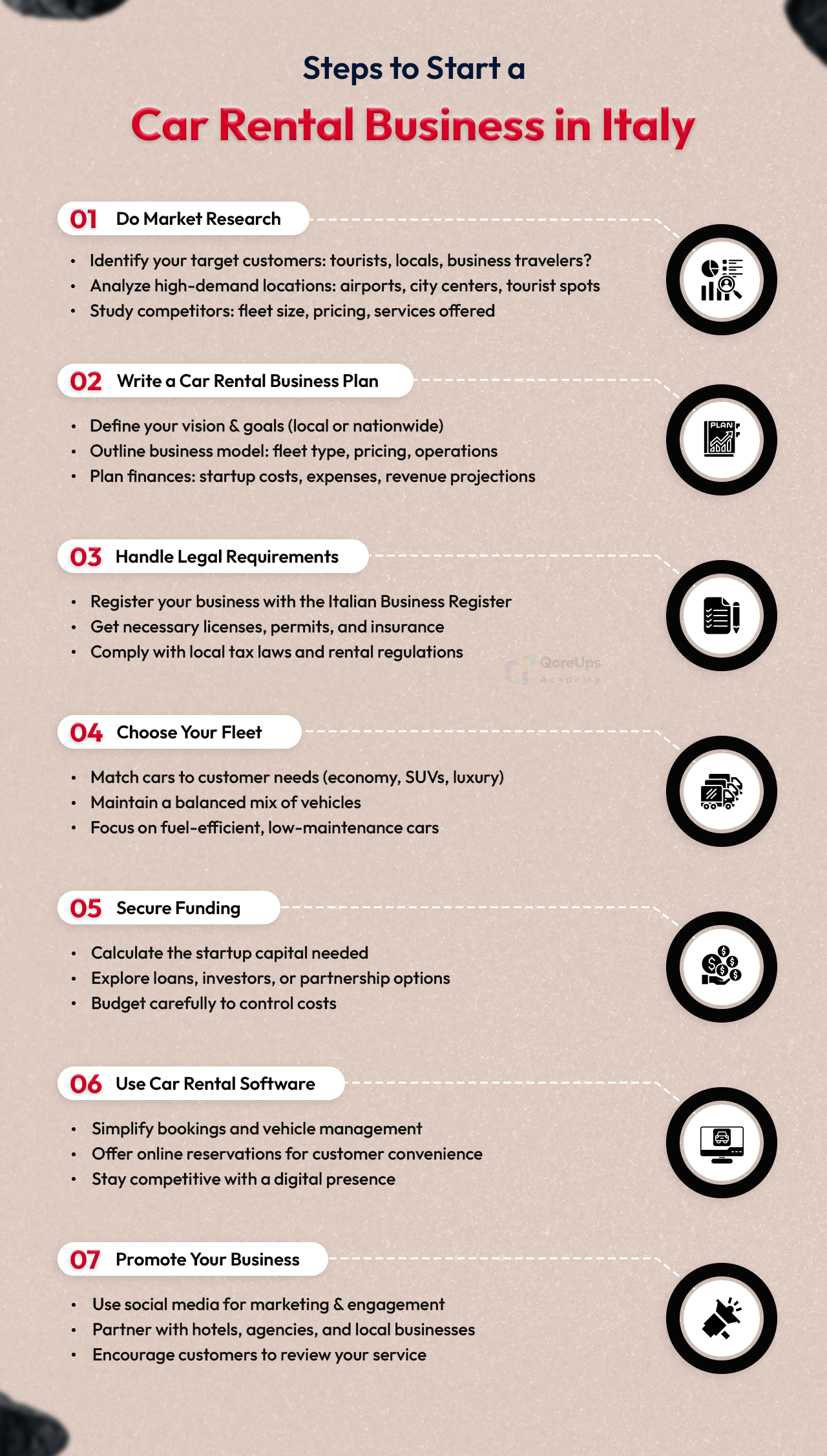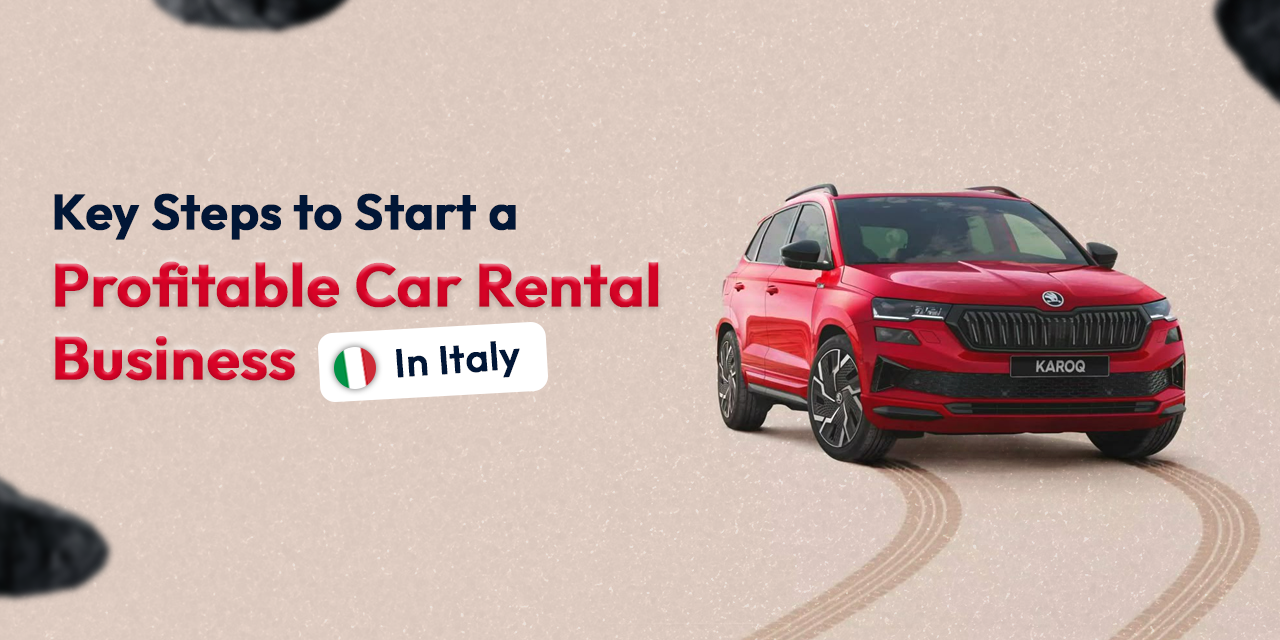Thinking about starting a car rental business in Italy?
Great idea!
Italy attracts millions of visitors each year. People don’t just come to see Rome or Venice.
They want to explore the Amalfi Coast, drive through Tuscany, visit small towns, or even steer to the Alps. Many of them need a car to do it.
It’s not just tourists, either.
Expats, students, and even natives sometimes rent cars.
That means the demand for car rentals is high in this region. But to turn it into a successful business, there are some key steps that you’ll need to follow.
In this blog, we’ll discuss all of them. Step by step. It’s easy to follow.
Let’s start…
Is Launching a Car Rental Business in Italy Profitable?
Absolutely—starting a car rental business in the Italian Republic can be profitable. But like any business, the success depends on how you set it up and run it.
Italy sees millions of visitors each year. Many of them want the freedom to travel beyond train routes and tour groups.
From driving through the mountain roads of the Dolomites to discovering the hidden beaches in Sicily, renting a car is often the easiest—and sometimes the only—way to truly experience this European country.
That creates a strong market for car rental services.
Also, the demand isn’t just seasonal. While summer is the busiest time, cities like Rome, Milan, and Florence attract worldwide business travelers and tourists year-round.
What makes this business especially appealing is its flexibility. You can start small with just a few cars and grow gradually. With smart planning, you can start earning returns quickly.
In short: YES, launching a car rental business in Italy can be profitable—but only if you do it in the right way.
Up next, we’ll explore the insights on the Italian car rental market.
Insights into the Italian Car Rental Market
Before you start, it’s crucial to understand the car rental market in Italy.
Market Size and Growth
- Italy’s car rental market is on the rise, with revenue expected to reach US$1.09 billion by 2029, according to Statista.
- The number of users is also growing, with over 4.33 million people expected to use rental services by 2030.
- Online bookings are becoming the norm in this car rental sector and are projected to generate 61% of total revenue by 2030.
Trends
- Tourism plays a huge part in Italy’s economy, and more visitors mean more demand for rental cars.
- More and more people are booking rental cars online thanks to the ease of using websites and apps.
- Demand for electric and hybrid cars is growing fast.
- Renting luxury cars is becoming popular, especially among tourists who are looking to explore Italy in style and comfort.
Competitors in Italy’s Car Rental Industry
- Big international brands like Avis, Europcar, Alamo, and Hertz dominate much of the market.
- Other key players include SIXT and Sicily by Car, a well-known local company.
Understanding the market is your first big step. Next, let’s look at the key steps to set up your car rental business in Italy.

Steps to Start a Car Rental Business in Italy
Starting a car rental business may seem challenging at first, but with a clear step-by-step plan, it’s completely doable—and even exciting! Here’s how you can make it happen:
1. Do Market Research
Good market research will help you make smart decisions and set your business up for success. Here’s how to approach it:
a) Identify Your Target Customers
Start by figuring out who will rent your cars.
Are they mostly tourists, business travelers, locals, or students?
Because different groups have distinct vehicle needs.
For example, tourists mostly prefer to rent small, fuel-efficient cars for city exploring. On the other hand, families may want to lease SUVs or vans.
Therefore, understanding your customers and what they truly need will allow you to tailor your vehicle choices and services to match their expectations.
b) Analyze Demand and Locations
Look at where the car rental demand is constant and highest in Italy.
Is it near airports, train stations, popular tourist spots, or city centers?
Certain regions or cities may have more rental activity due to tourism or business hubs.
Knowing this will help you pick the best place to start or focus your services.
c) Study Your Competitors
Find out who your competitors are and what types of car rental services they are offering in the market.
How many cars do they rent? What kinds of vehicles do they use? How much do they charge for a rental?
Study what are their strengths and weaknesses.
This analysis of competitors will let you find the good opportunities in the market—maybe a type of car or service they don’t offer—that you can use to stand out.
2. Write a Car Rental Business Plan
“A business plan is your map to success.” It keeps you aligned with your goals and ready for the unexpected. Here’s what an effective car rental business plan should include:
a) Define Your Vision and Goals
Start by writing down what do you want to achieve.
- Do you want to run a small car rental business in one city?
- Or do you have any plans to expand it to multiple locations across Italy?
Set both short-term and long-term goals that you want to achieve.
Your vision gives your business a direction, while your goals will help you measure the progress along the way.
b) Outline Your Business Model
This is the part where you will bring your rental business ideas to life. You’ll define how it will all work. This will show that you’ve thought through the day-to-day operations, logistics, and strategy. Think about:
- Your target customers (tourists, locals, businesses)
- Fleet types (economy cars, SUVs, luxury, electric vehicles)
- Pricing strategy (daily rates, discounts, seasonal pricing)
- Location (airport-based, city center, tourist hubs)
- Operations (staffing, insurance, vehicle maintenance, booking process)
This section will help you plan to meet customer needs and stand out from competitors in the market.
c) Plan Your Finances
Your financials will tell the real story of your business. This section will show that if you can make profits, manage the costs, and grow the business. This part of your plan should include:
- The startup costs (vehicles, office space, insurance, website, car rental software)
- The operating expenses (fuel, staff salaries, maintenance, taxes)
- The revenue projections (how much money do you expect to earn monthly/yearly)
- Break-even point (when your income covers your expenses)
If you’re looking for investors or loans for funding, a realistic financial plan shows that you’re trustworthy.
A well-thought-out business plan will help you turn an idea into a real startup project.
3. Handle Legal Requirements
Italy has specific regulations for car rental businesses. To run your startup legally, you’ll need to follow some national and local rules of this country.
A. Register Your Business
First, you must register your car rental business with the Italian Business Register (Registro delle Imprese). Then you’ve to choose the appropriate legal structure (e.g., sole proprietorship, SRL).
B. Licenses, Permits & Insurance
Operating a car rental business in Italy requires specific licenses and authorizations, often issued by the local municipality (Comune). You must also obtain the comprehensive vehicle insurance and third-party liability insurance for customer use. These are legally required for every vehicle in your fleet.
Additionally, Italy has strict regulations concerning drivers and rental conditions:
- Renters must have a valid driving license. If their license is from outside the EU, an International Driving Permit (IDP) may be required.
- Age restrictions typically require renters to be at least 21 years old. Drivers who are under the age of 25 may have to pay surcharges.
- Mandatory insurance includes Collision Damage Waiver (CDW) and Theft Protection. Additional coverage options are also available.
C. Local Compliance & Taxes
Comply with Italian tax laws, including VAT (IVA), corporate or personal income taxes, and municipal taxes. Regulations may vary by region or city. So it’s essential to consult your local municipality (Comune) or a qualified accountant (commercialista).
4. Pick Your Cars Carefully
Choosing the right vehicles is pivotal to the success and profitability of your car rental business. Consider the following factors to build an exemplary fleet:
A. Match the Market
Select the cars based on your target customers. City travelers often prefer small, fuel-efficient cars, while families or groups may need SUVs or vans. If you’re operating the business in a wealthy neighborhood, consider to add a few luxury models to your fleet.
B. Balance Your Fleet
Start with a small but varied selection of vehicles. Don’t focus too much on just one type. Have a mixture of vehicle types so you can serve various travelers, whether they need economy cars for daily use, larger vehicles for families, or premium options for special occasions. This will help you get customers throughout the year.
C. Consider the Costs
Prioritize cars with low fuel consumption, reliable performance, and affordable maintenance. Choosing such varieties of cars helps lower your ongoing expenses and boosts your overall profits.
5. Get Funding
To launch a car rental business, you should have sufficient funds. If you lack adequate budgets, exploring external financing options can help you get started.
A. Know Your Budget Needs
Calculate how much capital you need for purchasing vehicles, securing a suitable rental location, and managing startup expenses (like licenses, insurance, and marketing). This will help you set a clear financial goal.
B. Explore Funding Sources
Look into funding options such as bank loans, investors, or partners to secure the money you need to launch your business.
C. Manage Costs Wisely
Instead of purchasing new vehicles, leasing cars can help you avoid large initial costs. Creating a detailed budget plan helps you to control expenses effectively.
If you want a detailed overview of the costs involved, check out our blog on How Much to Start A Car Rental Business. It’ll help you plan the budget effectively.
6. Choose a Car Rental Software
In today’s digital world, equipping online car rental software is not optional—it’s essential for your business success. Here are the three significant benefits of the best car rental software:
A. Simplify Operations
A reliable car rental business software simplifies your day-to-day tasks like managing bookings, tracking vehicles, and processing payments. It’ll help you to run the business more efficiently.
B. Enhance Customer Experience
A good car rental software allows you to offer online booking, making it easy and convenient for customers to reserve vehicles anytime, anywhere. This speeds up the reservation process, improves customer satisfaction, and encourages repeat bookings.
C. Stay Competitive
In the digital age, having an online presence is key to staying competitive. It meets customer expectations, keeps you on par with industry leaders, and helps your business stand out in a crowded market.
7. Promote Your Car Rental Business
Promoting your car rental service is the key to increasing your business visibility, standing out in the market, and attracting more customers. Here are some effective strategies you can use to promote your business:
A. Leverage Social Media Platforms
Use social media platforms like Instagram, Facebook, WhatsApp Business, and X (Twitter) to engage with travelers and locals.
Share high-quality photos and videos of your vehicles, post special offers, and run targeted ads to reach your ideal customers.
Use hashtags and local geotags to increase visibility.
Engage with followers by responding promptly to their comments and messages.
B. Form Strategic Partnerships
Partner with hotels, travel agencies, tour operators, and local businesses. Offering referral incentives encourages them to recommend your service to their customers, helping you expand your client base.
C. Encourage Customer Loyalty
Ask happy customers to review your service on Google, TripAdvisor, and social media. Create loyalty programs to reward customers who rent cars repeatedly from you. Offer special discounts during slow seasons to keep your business busy year-round.

Final Thoughts
Starting a car rental business in Italy has great potential, but success depends on careful planning and smart execution. Here’s a quick recap of the key steps we’ve discussed in this blog:
- Research your market – Know your customers, demand, and competition.
- Write a business plan – Define your goals, model, and financial plan.
- Handle legal requirements – Register your business, get licenses, and stay compliant.
- Choose the right cars – Offer a mix of vehicles, focus on fuel efficiency, and low maintenance costs.
- Secure funding – Know your budget, explore financing, and manage costs smartly.
- Use online car rental software – Simplify bookings, payments, and customer service to operate smoothly.
- Promote your business – Leverage social media, partnerships, and loyalty programs to grow your customer base.
Hope you’re ready to launch your journey.
We wish you success.
Buona fortuna! (Good luck!)






